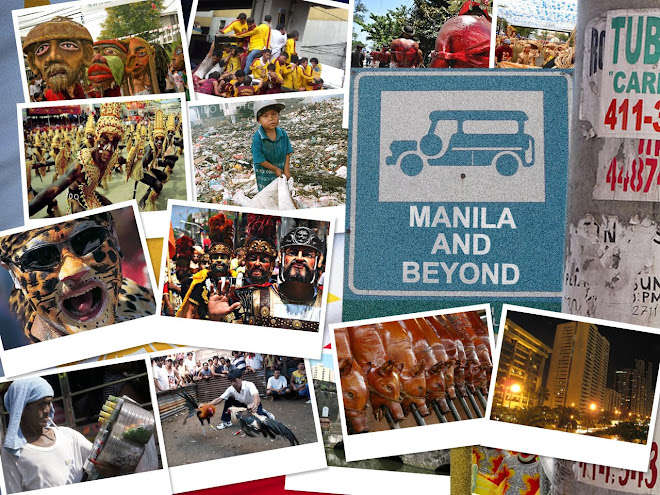
Thursday, April 21, 2011
Saturday, April 16, 2011
Holy Week Movies/TV Series of My Youth


Monday, March 28, 2011
My Present Guilty Pleasure: The Baker King

How To Be Prepared For An Earthquake In Manila
"...up to 35,000 residents of Metro Manila would die and up to three million others would need to be evacuated. In addition, some 175,000 buildings would be damaged. The pressure of collapsed buildings and the inability to rescue those who would be trapped inside would cause most of the deaths."
http://www.bulatlat.com/news/4-27/4-27-bigone.html

Back Again!

It has been so many weeks since I last updated. Charge it to busy schedule, preoccupations over recent global issues (i.e. Japan disaster - which affects me so since I have a good number of Japanese friends, thankfully they are ok, Libyan uprising, etc etc), and recently, a suddenly move to a place with limited access to internet.
Sunday, February 13, 2011
Jose Rizal Was The Quintessential Valentino :)

Sunday, January 2, 2011
HAPPY NEW 2011
Wednesday, September 15, 2010
A Dark Moment In Recent History, New Poll, And Akira Kurosawa

The bus of death. Photo from this site.
Last August 23, 2010, the entire Philippine nation and the world watched in horror as a hostage-taking drama came to a bloody end. There were nine casualties, which included eight
ex-policeman who was relieved from his position more than a year ago secondary to charges of robbery and extortion.
Since this harrowing incident, much has
happened, many of which are newsworthy, but nothing of this magnitude. It will definitely take time before
I can only hope for justice. For the rest of us, may we all learn something from this incident.
Nothing productive can be properly achieved from hate.

Ok ok. I sort of neglected this blog. I have been busy myself. My hands are full with exciting things to write and talk about. Too bad there are only 24 hours in a day, hahah.
One particular event that I am so excited about is the Akira Kurosawa film festival that is ongoing.
Oh God. Akira Kurosawa. I am one big fan. Need I enumerate his great works like Rashomon, Seven Samurai, Ran, Red Beard, and Dreams? This filmfest, which serves to celebrate Kurosawa’s 100th birth anniversary, is like a dream come true. The
What’s more, this affair is freaking FREE! *faint*
Read more here.
There is a new poll on the siderail that I would like you to check out. While you keep yourself busy with it, I will write my next post, and will be back sooner than you think. Take care and see you later.
Saturday, August 14, 2010
Manila Streetfood 1: Taho [Silken Tofu Dessert With Caramel and Tapioca Pearls]
Every Filipino (or those who have lived in the Philippines for quite sometime) knows what that call means. People from all walks of life would hurry up to meet that magtataho, usually a middle-aged man who carries two aluminum buckets connected to one another by a series of strings attached to a bamboo slab, which then rests on the man's shoulders as he walks around the area. Nowadays one can also see a taho vendor (complete with aluminum buckets and the rest of the contraptions) in the food courts of some big malls, even the supposedly posh ones like Powerplant Mall.
In this age when people work regardless of time of the day and 24/7 convenience stores are making a killing, it is not surprising to see a magtataho even during late at night. Times may have changed, but the taho will always be the Filipino's favorite dessert. And why is that?
Taho is nutritious and tastes so much better than cereal drinks that come in packs. A 150-ml taho (sold for 5 pesos, which is worth even less than 5 cents) is enough to sate in-between meal cravings, and in greater servings can even take the place of breakfast. Taho is a dessert that one can eat without feeling guilty about deliberately putting on extra pounds.
It is likewise easy to eat; in fact there are many ways to eat taho. It can be eaten from a bowl and scooped with a spoon. It can also be mixed into a loose flurry and sipped with a straw. For those who cannot be bothered by additional utensils, taho is drunk straight from the glass.
Taho is my personal favorite. While I am a big big fan of fruits, I never really enjoyed the more contemporary preparations of taho (those with added fruit toppings sold in the supermarkets and serve in some restaurants). I like taho just the way I have always had it ever since I was very young. Just the beautiful soya curd being caressed by the brown arnibal and playfully topped by soft tapioca. A mouthful of fun without a lot of frills.
Some more renowned Filipino blog sites likewise pay homage to this classic dessert.
In Dessert Comes First, the author describes how taho is served, from the aluminum bucket to the cup to her eager hands, the entire experience to "a thousand happy memories".
Taho breaks economic status barriers, and Marketman of Market Manila relates that Mang Amado, a magtataho, somehow manages to peddle taho in a gated village.
Lastly, Doc Emer of Parallel Universes has his own way of exalting the humble dessert: he enumerates taho's nutritional worth.
As for me, an unabashed taho fan ... well, if you are paying Manila a visit and want to try this delectable stuff, just give me a call, or leave a message on the blog, ok? ;)
[Unless otherwise indicated, all photos are by moi.]
Wednesday, July 28, 2010
Snapshot: Jollibee Fastfood
 Photo shows a Jollibee fastfood restaurant. Jollibee is probably the biggest fastfood chain in Manila and the entire Philippines. Initially a hamburger joint, Jollibee has, through the years, expanded its product range to include fried chicken, spaghetti (don't think Italian-type pasta recipe here, this is a modified recipe - sweet with hotdog bits incorporated in the sauce - to suite the taste of Filipino kids), sundaes, and rice meals which include burger steak, shanghai rolls, beef with mushroom, and crispy bangus (milkfish), to name a few.
Photo shows a Jollibee fastfood restaurant. Jollibee is probably the biggest fastfood chain in Manila and the entire Philippines. Initially a hamburger joint, Jollibee has, through the years, expanded its product range to include fried chicken, spaghetti (don't think Italian-type pasta recipe here, this is a modified recipe - sweet with hotdog bits incorporated in the sauce - to suite the taste of Filipino kids), sundaes, and rice meals which include burger steak, shanghai rolls, beef with mushroom, and crispy bangus (milkfish), to name a few.More about Jollibee here, and here, and definitely in the posts to follow.













